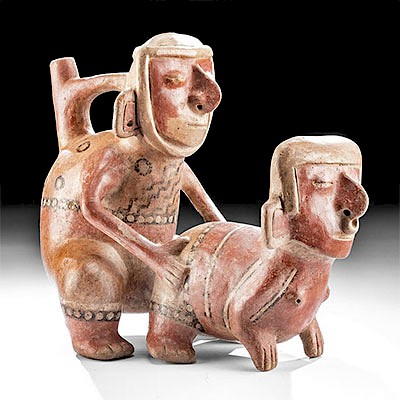Moche Bi-Chrome Seated Cazique Stirrup Vessel
Lot 28a
About Seller
Artemis Gallery
686 S Taylor Ave, Ste 106
Louisville, CO 80027
United States
Selling antiquities, ancient and ethnographic art online since 1993, Artemis Gallery specializes in Classical Antiquities (Egyptian, Greek, Roman, Near Eastern), Asian, Pre-Columbian, African / Tribal / Oceanographic art. Our extensive inventory includes pottery, stone, metal, wood, glass and textil...Read more
Categories
Estimate:
$4,000 - $6,000
Absentee vs Live bid
Two ways to bid:
- Leave a max absentee bid and the platform will bid on your behalf up to your maximum bid during the live auction.
- Bid live during the auction and your bids will be submitted real-time to the auctioneer.
Bid Increments
| Price | Bid Increment |
|---|---|
| $0 | $25 |
| $300 | $50 |
| $1,000 | $100 |
| $2,000 | $250 |
| $5,000 | $500 |
| $10,000 | $1,000 |
| $20,000 | $2,500 |
| $50,000 | $5,000 |
| $100,000 | $10,000 |
| $200,000 | $20,000 |
About Auction
By Artemis Gallery
Jan 30, 2020
Set Reminder
2020-01-30 10:00:00
2020-01-30 10:00:00
America/New_York
Bidsquare
Bidsquare : Pre-Columbian | Tribal | Ethnographic
https://www.bidsquare.com/auctions/artemis-gallery/pre-columbian-tribal-ethnographic-4830
Featuring ancient and ethnographic art from around the world, including Pre-Columbian, Native American, African / Tribal, Oceanic, Ethnographic, Spanish Colonial, Fossils, Fine Art, much more. Artemis Gallery info@artemisgallery.com
Featuring ancient and ethnographic art from around the world, including Pre-Columbian, Native American, African / Tribal, Oceanic, Ethnographic, Spanish Colonial, Fossils, Fine Art, much more. Artemis Gallery info@artemisgallery.com
- Lot Description
Pre-Columbian, North Coast Peru, Moche, ca. 600 to 800 CE. A seated figural vessel in the form of a jaguar-headdressed cazique, shaman, or warrior, seated with both hands placed upon the thighs of his folded legs. He wears a tunic with a faint checkered pattern and a delineated belt and collar. Atop his head is a magnificent headdress with two fierce blade forms flanking a jaguar head, probably implying that the individual it depicts wore and actual jaguar head. The figure is also bedecked with enormous round earspools. His face is expressive, with large, coffee bean shaped eyes, tattoo markings or face paint resembling a mask, and a determined, tight-lipped gaze. A stirrup handle projects from the back of the figure and a tall, cylindrical spout rises above his head. Size: 7.5" L x 7" W x 9.75" H (19 cm x 17.8 cm x 24.8 cm)
Jaguar imagery symbolized power and might throughout the Pre-Columbian world; hence, warriors, rulers, hunters, and shamans alike associated themselves with this king of beasts, the largest and most powerful feline in the New World. For the Moche and others, it symbolized a fierceness as well as an individuality that they identified with leaders in their society.
Provenance: private Lewis collection, Florida, USA; ex-Arte Primitivo, New York, USA, March 6, 2017, Lot #224; private Nevada, USA collection, acquired from Foreign Unlimited, Coconut Grove, Florida, USA, 1970s, item #3818FU. Exhibited at the Marjorie Barrick Museum, UNLV, early 1990s.
All items legal to buy/sell under U.S. Statute covering cultural patrimony Code 2600, CHAPTER 14, and are guaranteed to be as described or your money back.
A Certificate of Authenticity will accompany all winning bids.
We ship worldwide and handle all shipping in-house for your convenience.
#150425Normal surface wear with fading to checkerboard pattern on tunic (though it is still somewhat discernible) and other areas. Chips to rim of spout - possible repairs to spout/handle/head, but if so, very well done. Minute nicks to peripheries of earspools (possibly reattached), lips, knees, headdress blades, and other high-pointed areas. Collection label and mineral deposits on underside.Condition
- Shipping Info
-
All shipping is handled in-house for your convenience. Your invoice from Artemis Gallery will include shipping calculation instructions. If in doubt, please inquire BEFORE bidding for estimated shipping costs for individual items.
-
- Buyer's Premium



 EUR
EUR CAD
CAD AUD
AUD GBP
GBP MXN
MXN HKD
HKD CNY
CNY MYR
MYR SEK
SEK SGD
SGD CHF
CHF THB
THB
















